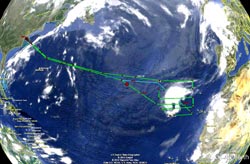NASA's Global Hawk and Satellites See Tropical Storm Nadine Turning Around

The fifth science flight of NASA's Global Hawk (green line) concluded when the aircraft landed at NASA's Wallops Flight Facility, Wallops Island, Va. on Sunday, Sept. 23 after flying over Tropical Storm Nadine in the Eastern Atlantic Ocean. The HS3 scientists changed the flight path (the original plan is in blue) during the GH flight to be able to overfly Nadine's center. Measurements from dropsondes found wind speeds greater than 60 knots at lower levels above the surface during that adjusted flight leg. Despite the large distance of Nadine from the U. S. East Coast, the Global Hawk was able to spend about 11 hours over the storm. The image shows the Global Hawk (red dot) returning to Wallops. Credit: NASA Wallops<br>
The fifth science flight of NASA's Global Hawk concluded when the aircraft landed at NASA's Wallops Flight Facility, Wallops Island, Va. on Sunday, Sept. 23 after flying over Tropical Storm Nadine in the Eastern Atlantic Ocean. The Hurricane and Severe Storms Sentinel (HS3) mission scientists changed the flight path during the Global Hawk flight to be able to overfly Nadine's center.
“Measurements from dropsondes found wind speeds greater than 60 knots at lower levels above the surface during that adjusted flight leg,” said Scott Braun, HS3 Mission Principal Investigator from NASA's Goddard Space Flight Center, Greenbelt, Md. “Despite the large distance of Nadine from the U. S. East Coast, the Global Hawk was able to spend about 11 hours over the storm.”
NASA's Aqua satellite passed over the eastern Atlantic Ocean on Sept. 24 at 03:23 UTC, and the Atmospheric Infrared Sounder (AIRS) instrument captured an infrared image of Tropical Storm Nadine's cloud top temperatures. The infrared data indicated the strongest thunderstorms and heaviest rainfall were to the northeast of the center of circulation. Those cloud top temperatures exceeded -63 Fahrenheit (-52 Celsius). Wind shear from the southwest has pushed the bulk of clouds and showers to the northeast.
On Friday, Sept. 24 at 11 a.m. EDT, Tropical Storm Nadine's maximum sustained winds are near 50 mph (85 kmh). Nadine was located about 440 miles (705 km) south of the Azores, near latitude 31.7 north and longitude 27.8 west. Nadine is moving west-northwest near 7 mph (11 kmh) and a gradual turn to the west and southwest is expected later.
The Hurricane and Severe Storm Sentinel (HS3) is a five-year mission specifically targeted to investigate the processes that underlie hurricane formation and intensity change in the Atlantic Ocean basin. HS3 is motivated by hypotheses related to the relative roles of the large-scale environment and storm-scale internal processes.
Text credit: Rob Gutro
NASA's Goddard Space Flight Center, Greenbelt, Md.
Media Contact
All latest news from the category: Earth Sciences
Earth Sciences (also referred to as Geosciences), which deals with basic issues surrounding our planet, plays a vital role in the area of energy and raw materials supply.
Earth Sciences comprises subjects such as geology, geography, geological informatics, paleontology, mineralogy, petrography, crystallography, geophysics, geodesy, glaciology, cartography, photogrammetry, meteorology and seismology, early-warning systems, earthquake research and polar research.
Newest articles

Ion thermoelectric conversion devices for near room temperature
The electrode sheet of the thermoelectric device consists of ionic hydrogel, which is sandwiched between the electrodes to form, and the Prussian blue on the electrode undergoes a redox reaction…

Zap Energy achieves 37-million-degree temperatures in a compact device
New publication reports record electron temperatures for a small-scale, sheared-flow-stabilized Z-pinch fusion device. In the nine decades since humans first produced fusion reactions, only a few fusion technologies have demonstrated…

Innovative microscopy demystifies metabolism of Alzheimer’s
Researchers at UC San Diego have deployed state-of-the art imaging techniques to discover the metabolism driving Alzheimer’s disease; results suggest new treatment strategies. Alzheimer’s disease causes significant problems with memory,…





















